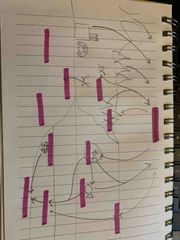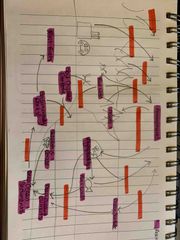![]()
![]()
![]()
Use LEFT and RIGHT arrow keys to navigate between flashcards;
Use UP and DOWN arrow keys to flip the card;
H to show hint;
A reads text to speech;
18 Cards in this Set
- Front
- Back

Reservoirs |
Atmosphere Plants Food web (land & sea) Soil organic C Fossil fuels Sedimentary rocks Shellfish and corals Deep ocean sediments Deep ocean currents Phytoplankton Ocean surface |
|

Flows |
Erupting volcanoes Burning fossil fuels Respiration Photosynthesis Diffusion Decomposition Weathering & erosion Sinking Rock cycle the |
|
|
The transfers in the carbon cycle act to... |
drive and cause changes in the carbon cycle over time |
|
|
Photosynthesis |
Carbon Dioxide + Water → Oxygen + Glucose Plants sequester carbon and reduce the potential impacts of climatechange. Chlorophyll in the leaves of the plant react with CO₂, to create the carbohydrate glucose. Photosynthesis helps to maintain the balance between oxygen and CO₂ in the atmosphere.
|
|
|
Respiration |
Oxygen + Glucose → Carbon Dioxide + Water During the day, plants photosynthesise, absorbing significantly more CO₂ than they emit fromrespiration. During the night they do not photosynthesise but they do respire, releasing moreCO₂ than they absorb. Overall, plants absorb more CO₂ than they emit, so are net carbondioxide absorbers (from the atmosphere) and net oxygen producers (to the atmosphere). |
|
|
Combustion |
When fossil fuels and organic matter such as trees are burnt, they emit CO₂ into the atmosphere, that was previously locked inside of them. This may occur when fossil fuels are burnt to produce energy, or if wildfires occur. |
|
|
Decomposition - |
When living organisms die, they are broken down by decomposers (such as bacteria and detritivores) which respire, returning CO₂ into the atmosphere. Some organic matter is also returned to the soil where it is stored adding carbon matter to the soil. |
|
|
Diffusion |
The oceans can absorb CO₂ from the atmosphere, which has increased ocean acidity by 30% since pre-industrial times. The ocean is the biggest carbon store, but with carbon levels increasing seawater becomes more acidic which is harming aquatic life by causing coral bleaching. Many of the world’s coral reefs now under threat. |
|
|
Weathering and Erosion |
Rocks are eroded on land or broken down by carbonation weathering. Carbonation weathering occurs when CO₂ in the air mixes with rainwater to create carbonic acid which aids erosion of rocks such as limestone. The carbon is moved through the water cycle and enters the oceans. Marine organisms use the carbon in the water to build their shells. Increasing carbon dioxide levels in the atmosphere, may increase weathering and erosion as a result, potentially affecting other parts of the carbon cycle.
|
|
|
Burial and Compaction |
When shelled marine organisms die, their shell fragments fall to the ocean floor and become compacted over time to form limestone. Organic matter from vegetation and decaying marine organisms is compacted over time, whether on land or in the sea, to form fossil fuel deposits.
|
|
|
Carbon Sequestration |
Transfer of carbon from the atmosphere to other stores and can be both natural and artificial. A plant sequesters carbon when it photosynthesises and stores the carbon in its mass. Factories are also starting to use carbon sequestration in the form of Carbon Capture and Storage (CCS). CO₂ is captured and transported via pipeline to depleted gas fields and saline aquifers. |
|
|
Advantages of factory carbon sequestering |
● Can be fitted to existing coal power stations.
● Captures 90% of CO₂ produced. ● There is a demand for CO ₂ (Coca-Cola, Plant Growth, Beer etc.), so transport systems via pipeline in liquid form already exist. ● Potential to capture half the world’s CO₂ emissions. |
|
|
Disadvantages of factory carbon sequestering |
● High cost is the main restriction to the growth of CCS. ● Increases energy demand of power stations. ● May not be space to fit it to existing power stations. ● Economically viable in some cases as it is used to push oil out the ground, thus further increasing fossil fuel usage. |
|
|
The carbon cycle occurs on a local scale... |
in a plant, or in a sere |
|
|
A sere is... |
a stage of a vegetation succession and can relate to specific environments. |
|
|
Lithosere stages |
Bare rock colonised, by pioneer community, for example, lichens, mosses, bacteria, that can survive in hardy conditions, and need few nutrients. Rock slowly weathered creating thin soil. Plants die, creating humus, leading to a more fertile soil, grasses replace the mosses and lichens as the dominant species. Grasses decrease in number, quick-growing shrubs become dominant. Fast growing trees dominate. Over time slower growing trees such as oak become dominant and form the climatic climax community. |
|
|
The climatic climax is... |
the final stage of the sere where environmental equilibrium is achieved. e.g. woodland or rainforest. When a sere reaches a climatic climax, the ecosystem is fully developed and stable. |
|
|
Examples of seres |
Lithosere - Bare rock Halosere - Salty environment Psammosere - Sand coastal environment Hydrosere - Freshwater environment |

